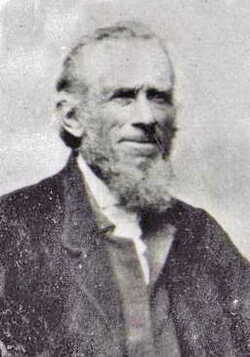
John Caleb Leatherman (1852-1952), who was a child during the Civil War and a neighbor of the man who would earn the sobriquet “Hero of Highland,” told a Hagerstown Daily Mail reporter in 1950, ”Boy, that ol’ George Blessing was a spunky one. Those Rebels were trying to get a hold of all the horses they could. When [my] Father heard about it, he took his horses up into Pennsylvania. Not George Blessing—he just stood pat on his own farm there.”
A barnyard shootout at Blessing’s Highland Farm took place on 9 July, 1864, the same day that the Battle of Monocacy was fought only a few miles away on the outskirts of Frederick City. At the end of that month, the Frederick Examiner ran a letter to the editor, suggesting “the raising of a sum, by the contributions of Union men … for the purpose of procuring a medal, with the appropriate device and inscription, to commemorate [Blessing’s] noble feats of that occasion.”
In the years that followed, the grandiosity of the tale and the pious nature of the hero was escalated by his niece, the writer Nellie Blessing Eyster, who published grandiose versions in both a noted ladies magazine and in her 1867 novel Chincapin Charlie. In the latter, she called him “one of Nature’s noblemen,” wrote that he was possessed of a “strange power” from “living so close to Jesus,” and that as he was “thoroughly imbued with the spirit of ’76, loving the government for which his fathers died, next to the God whom he so devoutly worshipped … he defended his home from what he sacredly believed an unrighteous invasion.”
To read the full article by historian Ann Longmore-Etheridge, click here.
A barnyard shootout at Blessing’s Highland Farm took place on 9 July, 1864, the same day that the Battle of Monocacy was fought only a few miles away on the outskirts of Frederick City. At the end of that month, the Frederick Examiner ran a letter to the editor, suggesting “the raising of a sum, by the contributions of Union men … for the purpose of procuring a medal, with the appropriate device and inscription, to commemorate [Blessing’s] noble feats of that occasion.”
In the years that followed, the grandiosity of the tale and the pious nature of the hero was escalated by his niece, the writer Nellie Blessing Eyster, who published grandiose versions in both a noted ladies magazine and in her 1867 novel Chincapin Charlie. In the latter, she called him “one of Nature’s noblemen,” wrote that he was possessed of a “strange power” from “living so close to Jesus,” and that as he was “thoroughly imbued with the spirit of ’76, loving the government for which his fathers died, next to the God whom he so devoutly worshipped … he defended his home from what he sacredly believed an unrighteous invasion.”
To read the full article by historian Ann Longmore-Etheridge, click here.
 RSS Feed
RSS Feed